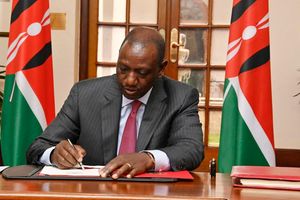
Kenya’s public debt shot up by Sh1.93 trillion in the year ended December 2023.
Kenya’s public debt stock ballooned by Sh860 billion within six months as it exceeded the legal limit, a report tabled in Parliament by the Office of the Controller of Budget (CoB) shows.
The details, contained in the national government’s budget implementation for the first six months of the 2023/24 financial year, show that as of June 30, 2023, the country’s public debt stood at Sh10.28 trillion but six months later- December 31, 2023, it had hit Sh11.14 trillion.
The debt rise of 8.4 per cent and comprises Sh6.09 trillion, about 54.7 per cent from external lenders, and Sh5.05 trillion, which is 45.3 per cent in domestic debt.
Also Read: Ruto borrows more than Uhuru, Kibaki with lower development despite collecting more in taxes
The revelations by the OCoB are not surprising as the National Assembly had in 2023 warned that the public debt was projected to surpass the Sh10 trillion mark by June 30, 2024.

Controller of Budget Margaret Nyakang’o.
The latest data by Controller of Budget, Dr Margaret Nyakang’o, reveals that at 11.8 per cent, the external debt recorded the highest growth with the domestic debt recording 4.5 per cent.
“A large proportion of the growth in external debt is attributed to the depreciation of the Kenya shilling against major world currencies,” says Dr Nyakang’o adding; “external debt stock is recorded in foreign currencies.”
The Public Finance Management (PFM) Act of 2012 states; “the national government may borrow money under this Act or any other legislation but shall not exceed the limit set by parliament.” In December 2023, parliament legislated the conversion of Kenya’s Sh10 trillion debt ceiling with a debt anchor set at 55 per cent of the country’s Gross Domestic Product (GDP) in net present terms.
In so doing, parliament provided a window not exceeding five per cent to accommodate the current debt threshold to GDP, which is 60 per cent.
At the time the debt ceiling was being changed from a nominal figure to a debt anchor, at 68 per cent of the GDP in public debt, the government was already in breach of the PFM Act.
“Notably, the public debt stock surpassed the parliamentary limit,” said Dr Nyakang’o. To check the escalation of public debt, Dr Nyakang’o recommends the need to reduce deficit budget financing through fiscal consolidation “to curb further growth of the public debt.”
“The growth in public debt strains the revenue as public debt is a first charge to the consolidated fund,” in reference to Article 214 (1) of the Constitution, which states that the public debt is a charge on the consolidated fund.
The CoB document indicates that the financing of the public debt during the period under review stood at Sh597.56 billion, representing 32 per cent of the revised annual estimates compared to Sh526.02 billion, which is 37.8 per cent recorded in a similar period of the 2022/23 financial year.












